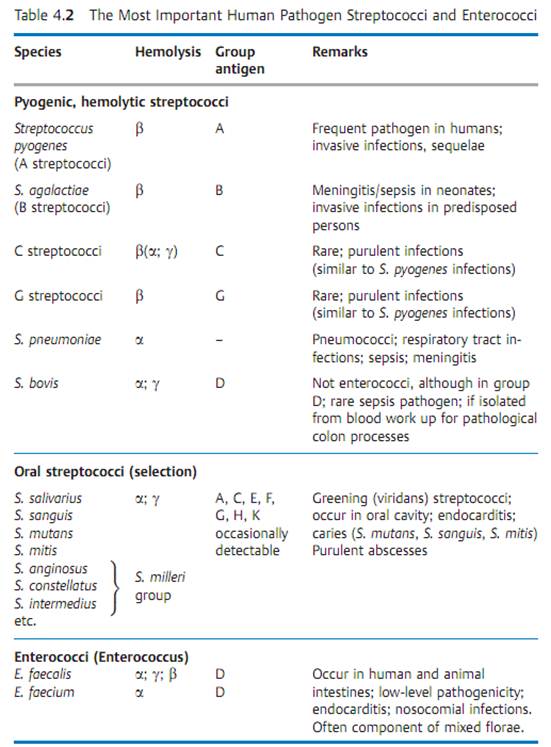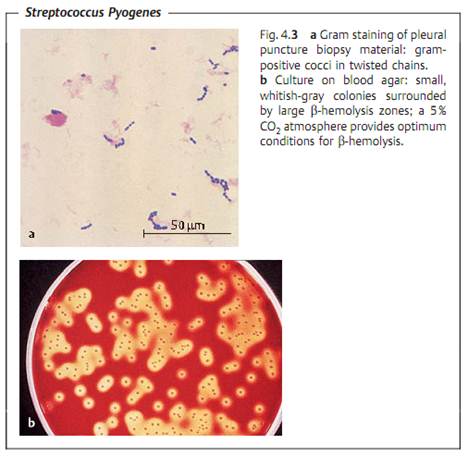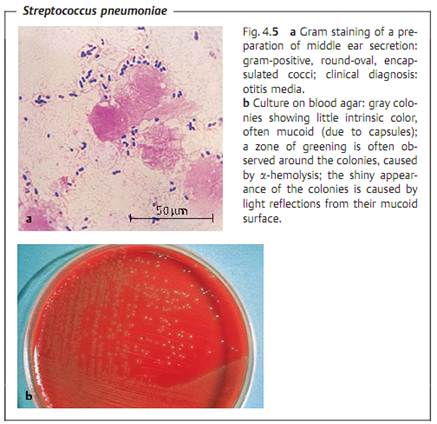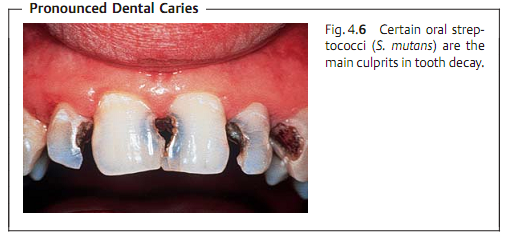


 النبات
النبات
 الحيوان
الحيوان
 الأحياء المجهرية
الأحياء المجهرية
 علم الأمراض
علم الأمراض
 التقانة الإحيائية
التقانة الإحيائية
 التقنية الحيوية المكروبية
التقنية الحيوية المكروبية
 التقنية الحياتية النانوية
التقنية الحياتية النانوية
 علم الأجنة
علم الأجنة
 الأحياء الجزيئي
الأحياء الجزيئي
 علم وظائف الأعضاء
علم وظائف الأعضاء
 الغدد
الغدد
 المضادات الحيوية
المضادات الحيوية|
Read More
Date: 2025-01-18
Date: 15-3-2016
Date: 10-3-2016
|
Streptococcus
Streptococci are Gram-positive, nonmotile, catalase-negative, facultatively anaerobic cocci that occur in chains or pairs. They are classified based on their hemolytic capacity (a-, b-, y-hemolysis) and the antigenicity of a carbohydrate occurring in their cell walls (Lancefield antigen).
B-hemolytic group A streptococci (S. pyogenes) cause infections of the upper respiratory tract and invasive infections of the skin and subcutaneous connective tissue. Depending on the status of the immune defenses and the genetic disposition, this may lead to scarlet fever and severe infections such as necrotizing fasciitis, sepsis, or septic shock. Sequelae such as acute rheumatic fever and glomerulonephritis have an autoimmune pathogenesis. The a-hemolytic pneumococci (S. pneumoniae) cause infections of the respiratory tract. Penicillins are the antibiotics of choice. Resistance to penicillins is known among pneumococci , and is increasing.
Laboratory diagnosis involves pathogen detection in the appropriate material. Persons at high risk can be protected from pneumococcal infections with an active prophylactic vaccine containing purified capsular polysaccharides. Certain oral streptococci are responsible for dental caries. Oral streptococci also cause half of all cases of endocarditis.
Although enterococci show only low levels of pathogenicity, they frequently cause nosocomial infections in immunocompromised patients (usually as elements of a mixed flora).
Streptococci are round to oval, Gram-positive, nonmotile, nonsporing bacteria that form winding chains (streptos [greek] = twisted) or diplococci. They do not produce catalase. Most are components of the normal flora of the mucosa. Some can cause infections in humans and animals.
Classification
The genera Streptococcus and Enterococcus comprise a large number of species. Table 4.2 lists the most important.
- α-, β-, y-hemolysis.
α -hemolysis. Colonies on blood agar are surrounded by a green zone. This “greening” is caused by H2O2, which converts hemoglobin into methemoglobin.
β -hemolysis. Colonies on blood agar are surrounded by a large, yellowish hemolytic zone in which no more intact erythrocytes are present and the hemoglobin is decomposed.
y-hemolysis. This (illogical) term indicates the absence of macroscopically visible hemolytic zones.
-Lancefield groups. Many streptococci and enterococci have a polymeric carbohydrate (C substance) in their cell walls called the Lancefield antigen. They are classified in Lancefield groups A-V based on variations in the antigenicity of this antigen.
Specific characteristics of enterococci that differentiate them from streptococci include their ability to proliferate in the presence of 6.5% NaCl, at 45 °C and at a pH level of 9.6.

Streptococcus pyogenes (A Streptococci)
Morphology and culturing. Gram-positive cocci with a diameter of 1 µm that form chains (Fig. 4.3a). Colonies on blood agar (Fig. 4.3b) show β-hemolysis caused by streptolysins (see below).
Fine structure. The murein layer of the cell wall is followed by the sero-group A carbohydrate layer, which consists of C substance and is covalently bound to the murein. Long, twisted protein threads that extend outward are anchored in the cell wall murein: the M protein. A streptococci are classified in serovars with characteristic M protein chemistry. Like the hyaluronic acid capsules seen in some strains, the M protein has an antiphagocytic effect.

Extracellular toxins and enzymes. The most important in the context of pathogenicity are:
- Streptolysin O, streptolysin S. Destroy the membranes of erythrocytes and other cells. Streptolysin O acts as an antigen. Past infections can be detected by measuring the antibodies to this toxin (antistreptolysin titer).
- Pyrogenic streptococcal exotoxins (PSE) A, B, C. Responsible for fever, scarlet fever exanthem and enanthem, sepsis, and septic shock. The pyro- genic exotoxins are superantigens and therefore induce production of large amounts of cytokines (p. 77).
- Streptokinase. Dissolves fibrin; facilitates spread of streptococci in tissues.
- Hyaluronidase. Breaks down a substance that cements tissues together.
- DNases. Breakdown of DNA, producing runny pus.
Pathogenesis and clinical pictures. Streptococcal diseases can be classified as either acute, invasive infections or sequelae to them.
- Invasive infections. The pathogens enter through traumas or microtraumas in the skin or mucosa and cause invasive local or generalized infections (Fig. 4.4). The rare cases of severe septic infection and necrotizing fasciitis occur in persons with a high-risk MHC II allotype. In these patients, the PSE superantigens (especially PSEA) induce large amounts of cytokine by binding at the same time to the MHC II complex and the b chain of the T cell receptor. The excess cytokines thus produced are the cause of the symptoms.
- Sequelae. Glomerulonephritis is an immune complex disease and acute rheumatic fever may be a type II immune disease .
Diagnosis. What is involved in diagnosis is detection of the pathogen by means of microscopy and culturing. Group A antigen can be detected using particles coated with antibodies that precipitate agglutination (latex agglutination, coagglutination). Using these methods, direct detection of A streptococci in tonsillitis is feasible in the medical practice. However, this direct detection method is not as sensitive as the culture. Differentiation of A streptococci from other b-hemolytic streptococci can be realized in the laboratory with the bacitracin disk test, because A streptococci are more sensitive to bacitracin than the other types.
Therapy. The agents of choice are penicillin G or V. Resistance is unknown. Alternatives are oral cephalosporins or macrolide antibiotics, although resistance to the latter can be expected. In treatment of septic shock, a polyvalent immunoglobulin is used to inactivate the PSE.

Epidemiology and prophylaxis. Infection frequency varies according to geo-graphical area, season, and age. Humans are the only pathogen reservoir for S. pyogenes. Transmission is by direct contact (smear infection) or droplets. The incubation period is one to three days. The incidence of carriers among children is 10-20%, but can be much higher depending on the epidemiological situation. Carriers and infected persons are no longer contagious 24 hours after the start of antibiotic therapy. Microbiological follow-up checks of patients and first-degree contacts are not necessary (exception: rheumatic history).
In persons with recurring infections or with acute rheumatic fever in their medical histories, continuous penicillin prophylaxis with a long-term penicillin is appropriate (e.g., 1.2 million IU benzathine penicillin per month).
Streptococcus pneumoniae (Pneumococci)
Morphology and culturing. Pneumococci are Gram-positive, oval to lancet-shaped cocci that usually occur in pairs or short chains (Fig. 4.5a). The cells are surrounded by a thick capsule.
When cultured on blood agar, S. pneumoniae develop a-hemolytic colonies with a mucoid (smooth, shiny) appearance (hence “S” form, Fig. 4.5b). Mutants without capsules produce colonies with a rough surface (“R” form).
Antigen structure. Pneumococci are classified in 90 different serovars based on the fine chemical structure of the capsule polysaccharides acting as antigens. This capsule antigen can be identified using specific antisera in a reaction known as capsular swelling.
Pathogenesis and clinical pictures. The capsule protects the pathogens from phagocytosis and is the most important determinant of pneumococcal virulence. Unencapsulated variants are not capable of causing disease. Other potential virulence factors include pneumolysin with its effects on membranes and an IgA1 protease.
The natural habitat of pneumococci is provided by the mucosa of the upper respiratory tract. About 40-70% of healthy adults are carriers. Pneumococcal infections usually arise from this normal flora (endogenous infections). Predisposing factors include primary cardiopulmonary diseases, previous infections (e.g., influenza), and extirpation of the spleen or complement system defects.
The most important pneumococcal infections are lobar pneumonia and bronchopneumonia. Other infections include acute exacerbation of chronic bronchitis, otitis media, sinusitis, meningitis, and corneal ulcer. Severe pneumococcal infections frequently involve sepsis.

Diagnosis. The laboratory diagnosis includes detection of the pathogen in appropriate test samples by means of microscopy and culturing. Pneumococci can be differentiated from other a-hemolytic streptococci based on their greater sensitivity to optochin (ethyl hydrocuprein hydrochloride) in the disk test or their bile solubility. Bile salts increase autolysis in pneumococci.
Therapy. Penicillin is still the antibiotic of choice. There have been reports of high-frequency occurrence of strains resistant to penicillin (South Africa, Spain, Hungary, USA). These strains are still relatively rare in Germany, Switzerland, and Austria (5-10%). Macrolide antibiotics are an alternative to penicillins, but resistance to them is also possible.
Penicillin resistance is not due to penicillinase, but rather to modified penicillin-binding proteins (PBPs) to which penicillins have a lower level of affinity. PBPs are required for murein biosynthesis. Biochemically, penicillin re-
sistance extends to cephalosporins as well. However, certain cephalosporins (e.g., ceftriaxone) can be used against penicillin-resistant pneumococci due to their higher levels of activity.
Epidemiology and prophylaxis. Pneumococcal infections are endemic and occur in all seasons, more frequently in the elderly. Humans are the natural pathogen reservoir.
The vaccine product Pneumovax® is available for immunization purposes. It contains 25 mg of the purified capsule polysaccharides of each of 23 of the most frequent serovars. Eighty to ninety percent of all isolated pneumococci have antigens contained in this vaccine, which is primarily indicated in persons with predisposing primary diseases. There is also a seven-valent conjugate vaccine that is effective in children under two years of age . Exposure prophylaxis is not necessary.
Streptococcus agalactiae (B Streptococci)
B streptococci occasionally cause infections of the skin and connective tissues, sepsis, urinary tract infections, pneumonia, and peritonitis in immunocompromised individuals. About one in 1000 neonates suffers from a sepsis with or without meningitis. These infections manifest in the first days of life (early onset type) or in the first weeks of life (late onset type). In the early onset form, the infection is caused intra partum by B streptococci colonizing the vagina. Potential predisposing factors include birth complications, premature birth, and a lack of antibodies to the capsule in mother and neonate.
Oral Streptococci
Most of the oral streptococci of the type often known as the viridans group have no group antigen. They usually cause a-hemolysis, some y-hemolysis as well.
Oral streptococci are responsible for 50-70% of all cases of bacterial endocarditis, overall incidence of which is one to two cases per 100 000 annually. The origins of endocarditis lie in invasion of the vascular system through lesions in the oral mucosa. A transitory bacteremia results. The heart valves are colonized and a biofilm is formed by the organism. Predisposing factors include congenital heart defects, acute rheumatic fever, cardiac surgery, and scarred heart valves. Laboratory diagnosis of endocarditis involves isolation of the pathogen from blood cultures. Drug therapy of endocarditis is carried out with either penicillin G alone or combined with an aminoglycoside (mostly gentamicin). Bactericidal activity is the decisive parameter.

S. mutans, S. sanguis, and S. mitis are, besides Actinomyces viscosus and A. naeslundii, responsible for dental caries (Fig. 4.6). These streptococci can attach to the proteins covering the tooth enamel, where they then convert sucrose into extracellular polysaccharides (mutan, dextran, levan). These sticky substances, in which the original bacterial layer along with secondary bacterial colonizers are embedded, form dental plaque. The final metabolites of the numerous plaque bacteria are organic acids that breach the enamel, allowing the different caries bacteria to begin destroying the dentin.



|
|
|
|
التوتر والسرطان.. علماء يحذرون من "صلة خطيرة"
|
|
|
|
|
|
|
مرآة السيارة: مدى دقة عكسها للصورة الصحيحة
|
|
|
|
|
|
|
نحو شراكة وطنية متكاملة.. الأمين العام للعتبة الحسينية يبحث مع وكيل وزارة الخارجية آفاق التعاون المؤسسي
|
|
|